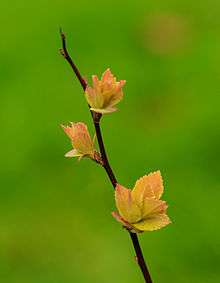Spiraea japonica
Spiraea japonica, the Japanese meadowsweet,[1] Japanese spiraea,[2] or Korean spiraea,[3] is a plant in the family Rosaceae.[4] Synonyms for the species name are Spiraea bumalda Burv. and Spiraea japonica var. alpina Maxim.[5]
| Spiraea japonica | |
|---|---|
| Inflorescence | |
| Scientific classification | |
| Kingdom: | Plantae |
| Clade: | Tracheophytes |
| Clade: | Angiosperms |
| Clade: | Eudicots |
| Clade: | Rosids |
| Order: | Rosales |
| Family: | Rosaceae |
| Genus: | Spiraea |
| Species: | S. japonica |
| Binomial name | |
| Spiraea japonica L.f. | |
Description
Spiraea japonica is one of several Spiraea shrubs with alternate, simple leaves, on wiry, freely branching, erect stems. Stems are brown to reddish-brown, round in cross-section and sometimes hairy. The shrub reaches 1.2 m to almost 2 m in height and about the same in width. The deciduous leaves are generally an ovate shape about 2.5 cm to 7.5 cm long, have toothed margins, and alternate along the stem. Clusters of rosy-pink flowers are found at the tips of the branches. The seeds measure about 2.5 mm in length and are found in small lustrous capsules.[5]
It is naturally variable in form and there are many varieties of it in the horticulture trade. So far, nine varieties have been described within the species.[5]
Distribution
_DSCF3559.jpg)

Spiraea japonica is a deciduous, perennial shrub native to Japan, China, and Korea. Southwest China is the center for biodiversity of the species.[5] It is naturalized throughout much of the Northeast, Southeast, and Midwest areas of the United States, and parts of Canada.[6]
Habitat
A common habitat for S. japonica in general seems to be in riparian areas, bogs, or other wetland habitats. It is found growing along streams, rivers, forest edges, roadsides, successional fields, and power line right-of-ways. It prefers full sun, but can tolerate partial shade. It prefers much water during the growing season; however, it cannot tolerate saturated soils for extended periods of time. It prefers a rich, moist loam, but it can grow in a wide variety of soils, including those on the alkaline side.[5]
Uses
Spiraea japonica was introduced in North America as an ornamental landscape plant and first cultivated in the northeastern states around 1870.[6]
Numerous cultivars have been selected for garden use. The tall forms may be grown as hedges, low screens, or foundation shrubs. The low-growing forms can be used as groundcover or in borders. In the UK, the following cultivars have gained the Royal Horticultural Society's Award of Garden Merit:-[7]
S. japonica has been used as traditional medicine by native people, and extracts from the plants were found to be bioactive.[5]
References
- "Spiraea japonica". Natural Resources Conservation Service PLANTS Database. USDA. Retrieved 27 November 2015.
- "BSBI List 2007". Botanical Society of Britain and Ireland. Archived from the original (xls) on 2015-01-25. Retrieved 2014-10-17.
- English Names for Korean Native Plants (PDF). Pocheon: Korea National Arboretum. 2015. p. 643. ISBN 978-89-97450-98-5. Archived from the original (PDF) on 25 May 2017. Retrieved 24 December 2016 – via Korea Forest Service.
- "Spiraea japonica". floridata.com. Retrieved 2008-10-08.
- "Spiraea japonica (shrub)". Invasive Species Specialist Group. Retrieved 2008-10-08.
- "Japanese spiraea". National Park Service. Retrieved 2008-10-08.
- "AGM Plants - Ornamental" (PDF). Royal Horticultural Society. July 2017. p. 99. Retrieved 1 November 2018.
- "RHS Plant Selector - Spiraea japonica 'Candlelight'". Retrieved 16 July 2013.
- "RHS Plant Selector - Spiraea japonica 'Dart's Red'". Retrieved 16 July 2013.
- "RHS Plant Selector - Spiraea japonica Golden Princess 'Lisp'". Retrieved 16 July 2013.
- "RHS Plant Selector - Spiraea japonica Magic Carpet 'Walbuma'". Retrieved 16 July 2013.
- "RHS Plant Selector - Spiraea japonica 'Nana'". Retrieved 16 July 2013.
External links
| Wikimedia Commons has media related to Spiraea japonica. |
- Species Profile - Japanese Spiraea (Spiraea japonica), National Invasive Species Information Center, United States National Agricultural Library. Lists general information and resources for Japanese Spiraea.